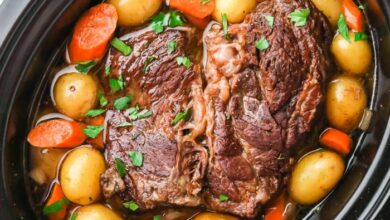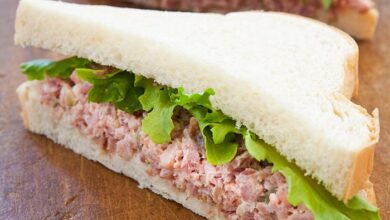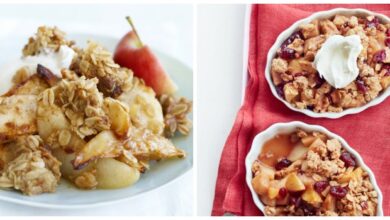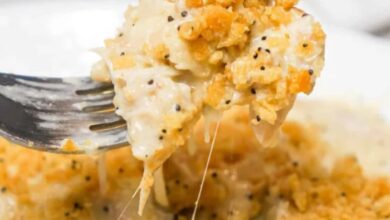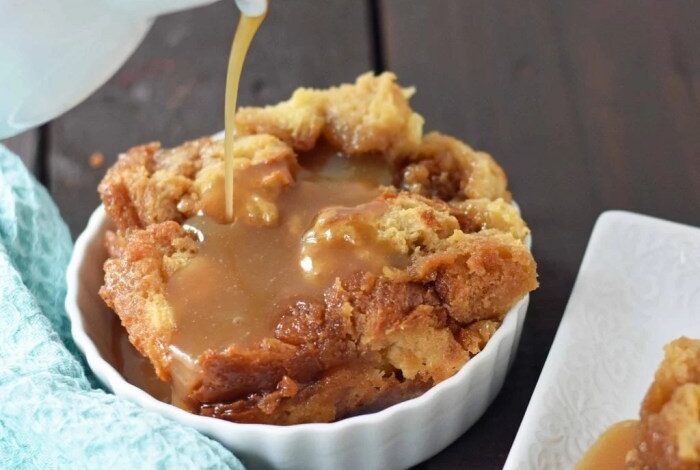
Bread Pudding with Caramel Sauce: A Sweet and Savory Delight
Bread pudding with caramel sauce is a dessert that’s both comforting and decadent. It’s a dish with a rich history, evolving from humble beginnings to become a beloved classic. The creamy, custardy texture of the bread pudding is perfectly complemented by the sweet, gooey caramel sauce, creating a symphony of flavors that tantalizes the taste buds.
Whether you’re a seasoned baker or a novice in the kitchen, this recipe is sure to impress.
The beauty of bread pudding lies in its versatility. It can be adapted to suit various dietary needs and preferences. From traditional recipes using stale bread and raisins to modern variations incorporating chocolate, nuts, and even fruits, there’s a bread pudding for every palate.
The caramel sauce, too, offers endless possibilities for customization. Whether you prefer a classic caramel or a more adventurous flavor like salted caramel or butterscotch, the possibilities are limitless.
History and Origins
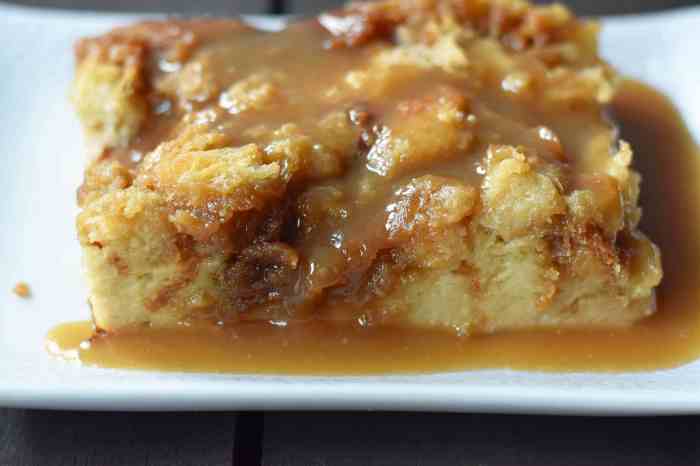
Bread pudding, a comforting and versatile dessert, has a rich history spanning centuries and continents. Its origins can be traced back to ancient times, where resourceful cooks utilized leftover bread to create a satisfying and economical dish.
Evolution of Bread Pudding
Bread pudding’s evolution into a popular dessert is a testament to its adaptability and enduring appeal. Over time, various cultures and culinary traditions have embraced and refined this humble dish, resulting in a diverse range of variations. The use of stale bread as a base for the pudding is a common thread throughout its history.
In medieval Europe, bread was a staple food, and leftover bread was often repurposed into a simple pudding, sweetened with honey or fruit. The introduction of sugar to Europe in the 15th century revolutionized bread pudding. Sugar’s affordability and availability allowed for sweeter and more decadent variations, transforming bread pudding from a basic sustenance dish to a sought-after dessert.
Notable Bread Pudding Variations
The global popularity of bread pudding has led to a wide array of regional variations, each showcasing the unique culinary traditions of its origin.
Bread pudding with caramel sauce is one of those desserts that always feels comforting and nostalgic. It reminds me of cozy evenings spent with family, sharing stories and laughter. But sometimes, I crave something a little more decadent, like a slice of Chantal’s New York cheesecake.
That creamy, tangy goodness is hard to resist! But no matter what, I always find myself coming back to the warm, comforting embrace of bread pudding with caramel sauce. It’s a classic for a reason.
- British Bread and Butter Pudding:This classic variation features slices of bread soaked in custard and layered with butter and raisins.
- French Pain Perdu:Meaning “lost bread,” this version is often served for breakfast or brunch and is characterized by its crispy exterior and custardy interior.
- American Bread Pudding:American bread pudding often incorporates spices like cinnamon, nutmeg, and vanilla, and is typically served warm with a rich sauce, such as caramel or bourbon sauce.
Ingredients and Variations
The beauty of bread pudding lies in its adaptability. While the basic recipe remains consistent, variations abound, reflecting regional preferences and creative flourishes. Let’s explore the core components and the exciting ways they can be transformed.
Classic Bread Pudding Ingredients
The foundation of a classic bread pudding recipe comprises a handful of essential ingredients:
- Stale Bread:The cornerstone of the dish, stale bread absorbs the custard mixture beautifully, creating a rich and comforting texture.
- Eggs:Binding the ingredients together, eggs provide structure and richness to the pudding.
- Milk or Cream:The liquid base for the custard, milk or cream adds moisture and enhances the flavor profile.
- Sugar:Sweetening the dish, sugar balances the richness of the eggs and milk.
- Spices:Cinnamon, nutmeg, and vanilla extract are common additions, imparting warmth and complexity to the flavor.
Common Variations and Regional Differences
Bread pudding has evolved over time, resulting in regional variations and unique adaptations:
- Southern United States:Southern bread pudding often features a generous amount of butter and brown sugar, creating a rich and decadent dessert.
- French Toast Bread Pudding:Inspired by French toast, this variation incorporates a batter similar to French toast batter, resulting in a more cake-like texture.
- Churro Bread Pudding:A modern twist, this variation incorporates churros, creating a sweet and crispy bread pudding experience.
Unique Ingredients and Flavor Combinations
Beyond the classic recipe, bread pudding offers endless possibilities for experimentation with unique ingredients and flavor combinations:
- Chocolate:Adding chocolate chips or cocoa powder to the custard creates a rich and decadent chocolate bread pudding.
- Fruits:Incorporating fresh or dried fruits like raisins, cranberries, or berries adds a burst of sweetness and flavor.
- Nuts:Toasted pecans, walnuts, or almonds add a crunchy texture and nutty flavor.
- Spices:Beyond cinnamon and nutmeg, explore other spices like cardamom, ginger, or cloves to create unique flavor profiles.
Caramel Sauce
Caramel sauce is the quintessential complement to bread pudding, adding a touch of sweetness and richness that elevates the dish to new heights. Its smooth, velvety texture and deep, complex flavor create a symphony of taste that tantalizes the palate.
Traditional Caramel Sauce Preparation
Traditional caramel sauce is a simple yet elegant creation that requires careful attention to detail. The process involves melting sugar over low heat, allowing it to caramelize, and then gradually incorporating butter and cream. The key to achieving a perfect caramel sauce lies in understanding the stages of sugar caramelization.
As the sugar melts, it transforms from a crystalline solid to a viscous liquid. As the temperature rises, the sugar molecules begin to break down, releasing water vapor and creating a rich, amber-colored caramel.
The process of caramelization is a delicate balancing act, requiring careful monitoring of the heat and timing. Overheating the sugar can lead to burning, resulting in a bitter and unpleasant flavor.
Caramel Sauce’s Role in Bread Pudding
The caramel sauce serves multiple purposes in bread pudding, enhancing both the flavor and texture of the dish.
- The sweetness of the caramel sauce balances the richness of the bread pudding, creating a harmonious flavor profile.
- The caramel sauce adds a layer of complexity to the bread pudding, introducing notes of butterscotch and toffee.
- The smooth, velvety texture of the caramel sauce provides a luxurious contrast to the soft, custardy texture of the bread pudding.
Caramel Sauce Variations
The classic caramel sauce can be adapted to create a variety of flavorful variations.
- Salted Caramel Sauce:A pinch of salt enhances the sweetness of the caramel sauce, creating a complex and savory flavor profile. The salt also balances the sweetness, preventing the sauce from being overly cloying.
- Butterscotch Sauce:Butterscotch sauce is a variation of caramel sauce that includes brown sugar, giving it a deeper, more robust flavor.
Cooking Methods and Techniques
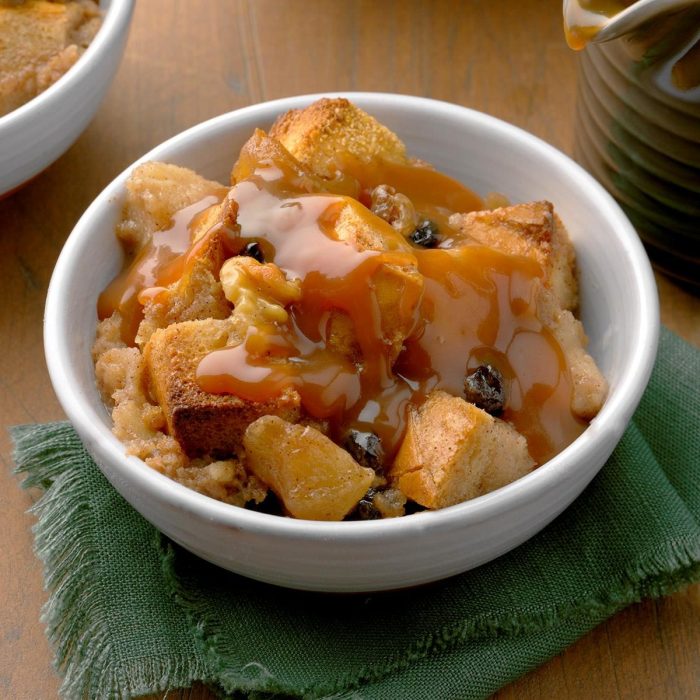
Baking bread pudding is a simple process, but there are a few key techniques that can help you achieve the perfect texture and consistency. The choice of cooking method depends on the desired outcome, and each method has its own advantages and disadvantages.
Oven Baking
Oven baking is the most common method for preparing bread pudding. It allows for even cooking and creates a beautifully golden-brown crust. The oven temperature and baking time are crucial for achieving a moist and flavorful bread pudding.
- Preheat the oven to 350°F (175°C) for optimal heat distribution and even cooking.
- Baking time typically ranges from 45 to 60 minutes, depending on the size and density of the bread pudding.
- A toothpick inserted into the center should come out clean when the bread pudding is fully cooked.
Slow Cooker
Using a slow cooker offers a hands-off approach to baking bread pudding. It allows for gentle cooking, resulting in a tender and moist texture.
- The slow cooker method requires a longer cooking time, typically 4-6 hours on low heat.
- The slow cooker provides a consistent temperature, minimizing the risk of overcooking.
- This method is ideal for busy individuals or those who prefer a more relaxed cooking experience.
Microwave
Microwave cooking offers a quick and convenient option for preparing bread pudding. However, it may not yield the same golden-brown crust as oven baking.
- Microwave cooking time varies depending on the microwave’s power and the size of the bread pudding.
- It is important to monitor the cooking process closely to prevent overcooking.
- Microwave cooking is best suited for smaller portions of bread pudding.
Serving and Presentation
Bread pudding, with its rich, comforting flavors and versatile nature, deserves a presentation that complements its deliciousness. Whether you’re serving it for a casual brunch or a formal dinner, a few simple touches can elevate your bread pudding from ordinary to extraordinary.
Serving Temperatures
Serving temperature significantly impacts the texture and enjoyment of bread pudding. Warm bread pudding offers a comforting, melt-in-your-mouth experience, while chilled bread pudding provides a refreshing contrast with its firmer texture.
- Warm:Serve warm bread pudding straight from the oven or after a brief rest. This allows the custard to remain soft and the flavors to meld. Warm bread pudding pairs well with a scoop of vanilla ice cream or a drizzle of caramel sauce.
- Chilled:Chilled bread pudding offers a delightful alternative. Allow the bread pudding to cool completely before refrigerating for at least two hours. This allows the custard to set, creating a firmer texture that holds its shape well. Chilled bread pudding can be served with fresh fruit, whipped cream, or a dollop of mascarpone cheese.
Presentation
Presentation is key to making your bread pudding visually appealing.
- Individual Portions:For a more elegant presentation, serve individual portions of bread pudding in ramekins or small bowls. This allows each guest to have their own beautifully presented portion.
- Sharing Platter:For a more casual setting, serve bread pudding on a large platter. Arrange the slices of bread pudding in a visually appealing manner, and drizzle with caramel sauce or garnish with fresh fruit.
- Garnish:Garnishing your bread pudding adds a touch of visual appeal and flavor. Consider using fresh berries, sliced bananas, chopped nuts, or a sprinkle of cinnamon. A sprig of mint or a dollop of whipped cream also adds a touch of elegance.
Bread pudding with caramel sauce is a classic comfort food that always hits the spot. It’s warm, gooey, and full of sweet, buttery flavor. If you’re looking for a similar dish that’s a little easier to make, you might want to try an easy french toast casserole.
It’s essentially the same concept, but with a slightly different flavor profile. But no matter which you choose, you’re sure to enjoy a delicious and satisfying breakfast or brunch.
Accompanying Beverages
Pairing your bread pudding with the right beverage enhances the overall dining experience.
- Coffee or Tea:The classic pairing for bread pudding, coffee or tea complements the richness of the dessert. A strong cup of coffee or a soothing cup of tea can cut through the sweetness of the bread pudding.
- Milk or Cream:For a lighter option, milk or cream provides a refreshing contrast to the richness of the bread pudding.
- Wine:For a more sophisticated pairing, consider a dessert wine like Sauternes or a sweet red wine like Port. These wines complement the caramel flavors of the bread pudding.
Culinary Science and Principles: Bread Pudding With Caramel Sauce
Bread pudding, a delightful dessert with a rich history, relies on a fascinating interplay of culinary science and principles to achieve its unique texture and flavor. The baking process transforms simple ingredients into a comforting and satisfying treat, involving the science of starch gelatinization, sugar caramelization, and the Maillard reaction.
Bread pudding with caramel sauce is a classic comfort food that always hits the spot. But sometimes, I crave something a little more savory, and that’s when I turn to Colleen’s slow cooker jambalaya , a hearty and flavorful dish that’s perfect for a chilly evening.
Of course, after a bowl of jambalaya, a warm slice of bread pudding with caramel sauce is the perfect way to end the meal.
Starch Gelatinization and Sugar’s Role in Texture and Flavor
Starch gelatinization is a crucial process in bread pudding, contributing to its texture and mouthfeel. Starch granules, present in bread and other ingredients, absorb water and swell when heated. This process, known as gelatinization, results in a thickened, creamy texture.
Sugar plays a vital role in enhancing flavor and texture. It contributes to sweetness and a golden-brown color, and also helps in moisture retention during baking.
Caramelization: The Chemistry of Flavor, Bread pudding with caramel sauce
Caramelization is a chemical reaction that occurs when sugar is heated to high temperatures. As sugar molecules break down, they undergo a series of complex transformations, resulting in the formation of hundreds of different compounds, each contributing to the characteristic aroma and flavor of caramel.
The Maillard reaction, another chemical process, also contributes to the browning and flavor development of bread pudding. This reaction occurs between amino acids and sugars, creating a wide range of flavorful compounds that contribute to the depth and complexity of the dish.
Cultural Significance and Traditions
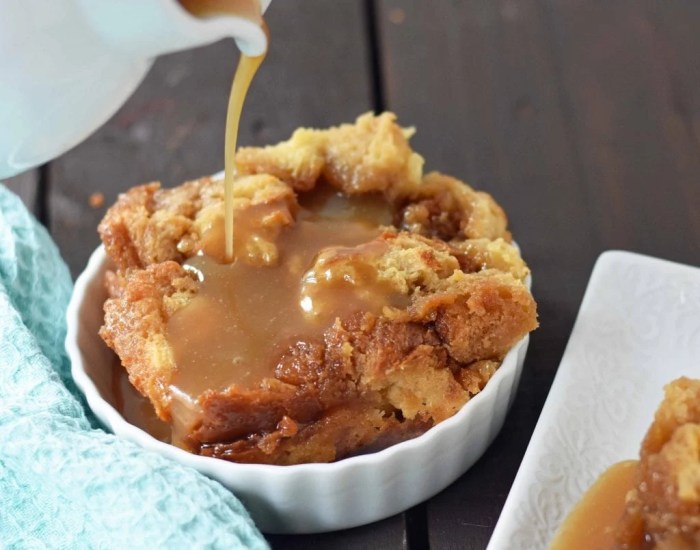
Bread pudding, with its humble origins and adaptable nature, has woven itself into the fabric of diverse cultures and culinary traditions around the world. This beloved dessert transcends borders and generations, reflecting the ingenuity of cooks and the shared love for comforting, sweet treats.
Bread Pudding’s Global Reach
Bread pudding’s widespread appeal is evident in its presence across continents, each region adding its unique flavor and cultural nuances.
- United Kingdom:In Britain, bread pudding often features in traditional English cuisine, particularly during the Victorian era. It’s frequently served with custard, a classic pairing that enhances the dish’s richness and creaminess.
- United States:American bread pudding often incorporates regional ingredients and flavors. For example, in the Southern United States, it’s commonly enriched with pecans and bourbon, reflecting the region’s culinary heritage.
- France:French bread pudding, known as “pain perdu,” translates to “lost bread.” This name hints at the dish’s origins as a way to utilize leftover bread, a practice common in many cultures. Pain perdu is often flavored with rum or brandy and served with a simple syrup or fruit compote.
- Caribbean:In the Caribbean, bread pudding is a staple dessert, often incorporating local fruits like mangoes, bananas, and papaya. The dish is typically flavored with spices like nutmeg, cinnamon, and cloves, adding a warm and aromatic dimension.
- Philippines:In the Philippines, bread pudding, known as “leche flan,” is a popular dessert. This version features a custard-like texture, achieved by using evaporated milk and condensed milk, creating a rich and creamy treat.
Health and Nutritional Aspects
Bread pudding with caramel sauce is a delicious and comforting dessert, but its nutritional value depends on the ingredients used and the portion size consumed. This section will delve into the nutritional profile of this classic dessert, exploring its potential health benefits and drawbacks, and offering tips for making healthier variations.
Nutritional Value
Bread pudding with caramel sauce is a high-calorie dessert due to its carbohydrate-rich base and the addition of sugar in the caramel sauce. The exact nutritional content varies based on the recipe and ingredients used. However, a typical serving of bread pudding with caramel sauce might contain around 300-400 calories, 50-60 grams of carbohydrates, 10-15 grams of fat, and 5-10 grams of protein.
Potential Health Benefits
While not considered a health food, bread pudding can offer some potential health benefits:
- Source of fiber:Bread pudding, especially when made with whole-grain bread, can provide some dietary fiber, which is essential for digestive health and can help regulate blood sugar levels.
- Nutrient-rich ingredients:Depending on the recipe, bread pudding can include other nutritious ingredients like fruits, nuts, and spices, which can contribute to the overall nutritional value of the dish.
Potential Drawbacks
Excessive consumption of bread pudding with caramel sauce can contribute to:
- Weight gain:The high calorie and sugar content can lead to weight gain if consumed regularly in large quantities.
- Blood sugar fluctuations:The high carbohydrate content can cause rapid spikes in blood sugar levels, especially for individuals with diabetes or insulin resistance.
- Dental problems:The high sugar content can contribute to tooth decay and cavities.
Healthier Variations
To make bread pudding a healthier option, consider these tips:
- Use whole-grain bread:Choosing whole-grain bread over white bread provides more fiber and nutrients.
- Reduce sugar:Use less sugar in the caramel sauce or opt for a sugar-free alternative.
- Add fruits and nuts:Incorporate fruits like berries and nuts for added fiber, vitamins, and healthy fats.
- Control portion sizes:Enjoy bread pudding in moderation as part of a balanced diet.


